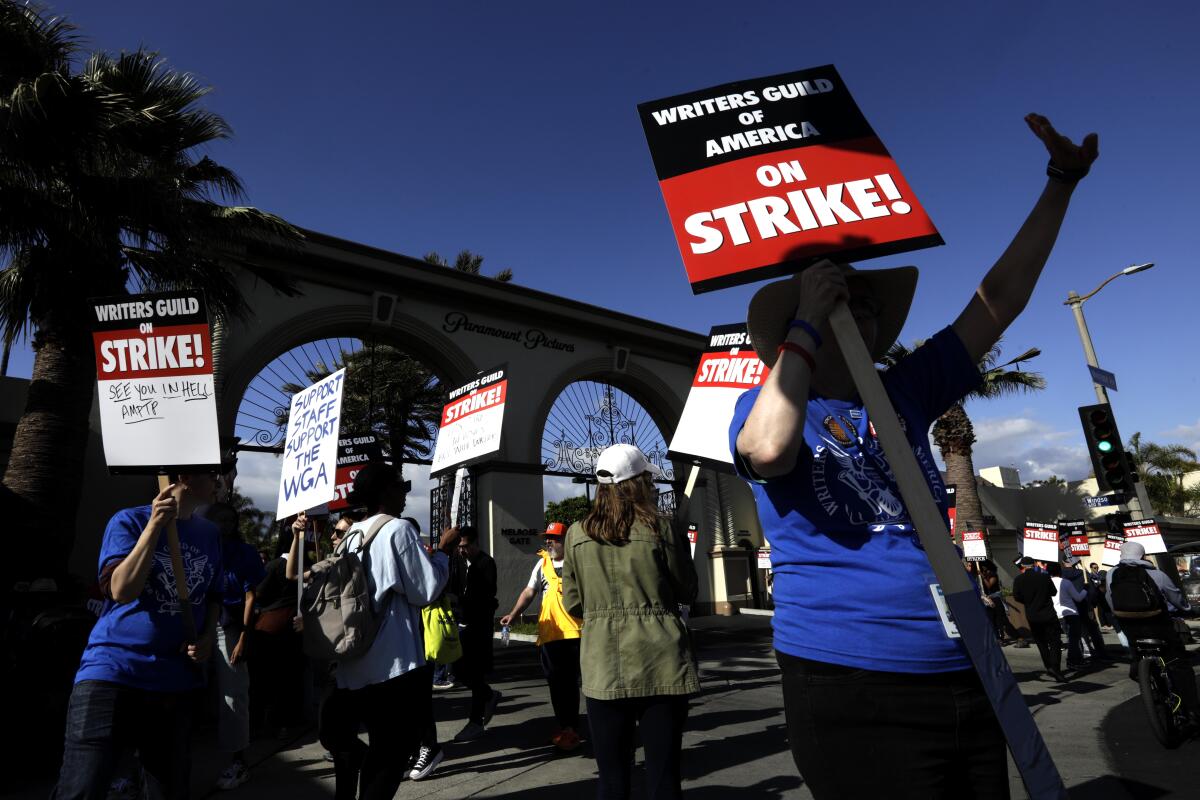Hollywood writers are on strike. Here’s what to expect

- Share via
Good morning, and welcome to the Essential California newsletter. It’s Wednesday, May 3.
For the first time in 15 years, Hollywood’s film and television writers on Tuesday put down their pencils — or, more likely, their laptops — as union members began a strike.
Writers are demanding higher wages and an overhaul of the residual payment process to reflect the modern age of streaming content. Talks between leaders of the Writers Guild of America and the Alliance of Motion Picture and Television Producers (AMPTP) reached an impasse, triggering the strike at 12:01 a.m.
Writers Guild members gathered in picket lines outside major studios, holding signs and chanting in unison.
The advent of streaming dramatically shifted how viewers consume entertainment.
Netflix, Hulu, Amazon Prime Video, Disney+ and an array of smaller and subsidiary streaming platforms have generated more shows and movies to watch (and rewatch) than ever before.
But that market flood depressed pay for writers, according to WGA leaders. A union survey found that half of series writers now earn scale (the minimum episodic or weekly rate), compared with 33% during the 2013-14 season.
That collective decline in pay comes at a time when the cost of living is increasing — especially in California.
Writers also point to a shift in the scale of individual programs, as my colleague Anousha Sakoui explained:
[Writers] say they are working for shorter periods of time and having to find several gigs a year to make ends meet. Typically, broadcast networks would order about 20 episodes for shows that would be worked on over 10 months. But in recent years, studios have more often focused on streaming short-order series with eight to 10 episodes.
AMPTP, which includes Netflix, Amazon, Apple, Disney, Discovery-Warner, NBC Universal, Paramount and Sony, issued a statement, saying it offered “generous increases in compensation for writers as well as improvements in streaming residuals.”
The alliance added that it was “unwilling” to improve on its offer due to “the magnitude of other proposals still on the table that the Guild continues to insist upon,” pointing to WGA’s demands over mandatory staffing levels and duration of employment.
Viewers will see the impacts of the strike as soon as tonight, as late-night shows go dark — the ones hosted by Stephen Colbert, Jimmy Fallon and the like, along with weekly staples like “Saturday Night Live” and “Last Week Tonight With John Oliver.”
Beyond the TV set, the strike will undoubtedly ripple across California’s economy, with halted production resulting in a loss of business for sectors that depend on feeding, transporting and housing film crews.
During the 2007-08 writers’ strike, the state’s economy lost an estimated $2.1 billion.
How long the strike will last is anyone’s guess. But as Ryan Faughnder, senior editor with The Times’ Company Town team, explained, it may come down to “an endurance test” for streaming services like Netflix, “that binged on content spending during the pandemic” and are sitting on a reserve of programming.
“We might start to see whether some studios have more of a stomach for the standoff than others,” Ryan wrote. “Or if a high-powered studio head is motivated to jump in as a uniting force to hammer out a compromise.”
For more on the writers’ strike, explore The Times’ team coverage. Here are a few stories to start with:
- ‘It’s just pure chaos’: Top Hollywood showrunners explain the writers’ strike
- How to tap the WGA strike funds and other financial aid during the writers’ strike
- What shows are affected by the writers’ strike? ‘SNL’ and late-night are among the first
- Striking Hollywood writers start looking for new gigs. Here are some ideas
And now, here’s what’s happening across California.
Note: Some of the sites we link to may limit the number of stories you can access without subscribing.
L.A. STORIES
Finding an apartment in L.A. isn’t for the faint of heart. Writer Zoë Bernard chronicled the struggle to secure a space in a humbling housing market. Los Angeles Times
Low wages and short hours are pushing many L.A. County fast-food workers into homelessness. A new report from the nonprofit Economic Roundtable found that people in fast food make up 11% of all homeless workers in California and 9% in L.A. County. Los Angeles Times
POLITICS AND GOVERNMENT
New documents published by the California Reparations Task Force indicate that it plans to recommend that the state consider “down payments” to eligible African American residents and issue an apology for racism and slavery. In the documents, task force members also suggest a process for calculating how much money African Americans in California have lost since the founding of the state due to discriminatory government practices. CalMatters
How’s The Golden State doing with its effort to build more housing? New figures from the California Department of Finance show that construction hit a 15-year high last year, with Los Angeles, San Diego and Oakland topping the state for the most total housing units and the most new multifamily construction. But the slight gain keeps California far behind the pace to address the housing crisis. The Sacramento Bee
A COVID-19 public health order that prevented asylum seekers from entering the U.S. in recent years expires next week. As an estimated 16,000 migrants wait in Tijuana, immigration officials in San Diego lack a specific plan to process their requests. KPBS
Support our journalism
HEALTH AND THE ENVIRONMENT
If you see California’s green hillsides and feel hopeful about the risk of wildfires, officials have a message for you: It’s only a matter of time. The state’s wet winter may delay the incoming fire season, but the dry season will do what it always does, priming fuel for the inevitable blaze. Los Angeles Times
For one California teen, coverage of early psychosis treatment proved to be a lifesaver. But many Californians lack access to that kind of coverage, which is highly dependent on which county they live in. Los Angeles Times
AND FINALLY
Today’s California landmark is from Steven Barra of Fresno: Forestiere Underground Gardens, a network of subterranean structures built by Baldassare Forestiere, an immigrant from Sicily who settled in Fresno.

Steve writes:
Legend has it that he came to Fresno to become a citrus farmer. But he discovered rather quickly that Fresno had some very hot summers. In an effort to accommodate some level of comfort, he began digging underground, using experiences from building the subway tunnels in New York, after leaving Italy, using only simple farm tools. His eventual goal was to create an underground resort. There is much more to the story, and the website really doesn’t give you much more information. But the tour gives you a lot!

What are California’s essential landmarks? Fill out this form to send us your photos of a special spot in California — natural or human-made. Tell us why it’s interesting and what makes it a symbol of life in the Golden State. Please be sure to include only photos taken directly by you. Your submission could be featured in a future edition of the newsletter.
Please let us know what we can do to make this newsletter more useful to you. Send comments to essentialcalifornia@latimes.com.
Sign up for Essential California
The most important California stories and recommendations in your inbox every morning.
You may occasionally receive promotional content from the Los Angeles Times.







